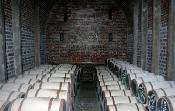Siege and Battle of Fort Pulaski - Savannah, Georgia
Siege and Battle of Fort Pulaski - Savannah, Georgia


| Marks of Battle at Fort Pulaski The outer walls of the historic fort still show the damage caused by Union cannon fire during the 1862 siege and battle. |
Magazine of Fort Pulaski
The impact of Union shells
against this magazine forced
the Confederate defenders of
Fort Pulaski to surrender.
The impact of Union shells
against this magazine forced
the Confederate defenders of
Fort Pulaski to surrender.


Rifled Guns vs. Brick Walls
The 1862 Siege and Battle of
Fort Pulaski proved that forts
of stone and brick could not
withstand long-range fire from
rifled artillery.
The 1862 Siege and Battle of
Fort Pulaski proved that forts
of stone and brick could not
withstand long-range fire from
rifled artillery.
Siege & Battle of Fort Pulaski - Savannah, Georgia
Rifled Artillery and Walls of Brick
| Copyright 2013 by Dale Cox All rights reserved. Last Updated: February 22, 2013 |


Custom Search
Civil War Sites in Georgia
The Immortal Six Hundred
Fort Pulaski National Monument
Old Fort Jackson Historic Site
Fort McAllister State Historic Site
Historic Sites in Savannah
Forts & Battlefields of the South
Explore other Southern Historic Sites
Fort Pulaski National Monument
Old Fort Jackson Historic Site
Fort McAllister State Historic Site
Historic Sites in Savannah
Forts & Battlefields of the South
Explore other Southern Historic Sites

The Breached Wall
In just two days, Union rifled
guns breached the wall of
Fort Pulaski, allowing shells
to explode against one of the
fort's primary magazines.
In just two days, Union rifled
guns breached the wall of
Fort Pulaski, allowing shells
to explode against one of the
fort's primary magazines.

The Breached Wall Today
The U.S. Army later repaired
the damage, but the site of
the history-changing breach
is still evident today.
The U.S. Army later repaired
the damage, but the site of
the history-changing breach
is still evident today.
One of the most significant battles in military
history was fought in 1862 for control of Fort
Pulaski, a masonry fort that guarded the
historic city of Savannah, Georgia.
The battle of Fort Pulaski was one of rifled
artillery versus masonry walls and it forever
changed the history of coastal defense not
just in America, but around the world. Two
days of bombardment proved that even the
strongest brick forts could not withstand the
power of rifled cannon.
Designed to protect the important port of
Savannah from foreign attack, Fort Pulaski
was considered one of the strongest forts in
America when the War Between the States or
Civil War broke out in April 1861. General
Joseph G. Totten, the U.S. Army's Chief of
Engineers, considered Fort Pulaski so
strong that he said an attacking force "might
as well bombard the Rocky Mountains."
General Robert E. Lee, who in 1862
commanded the defenses of Florida,
Georgia and South Carolina, was of a similar
opinion. Standing on the parapet of the fort
with its commander. Colonel Charles H.
Olmstead, he looked out at Tybee Island
where the Federals were erecting batteries
and said, "Colonel, they will make it pretty
warm for you here with shells, but they
cannot breach your walls at that distance."
Lee and Totten were wrong.
Captain Quincy A. Gillmore, General Thomas
W. Sherman's Chief Engineer, was assigned
to command the Union troops that had
landed on Tybee Island. An outstanding
military engineer, Gillmore proposed trying to
take the fort by bombarding it from long range
with newly developed rifled cannon. General
Sherman approved the attempt, even though
he did not believe it would prove successful.
Gillmore, however, relished the opportunity
that had been given to him. He directed the
work of Federal troops as they erected 11
batteries on the northwest shore of Tybee
Island.
Aware of the Union efforts, Colonel Olmstead
ordered the cannon of Fort Pulaski to open
fire on the night of March 22, 1862. The effort
to disrupt the work of the Federal soldiers
failed, however, and by early April the Tybee
Island batteries were ready for action.
The critical moment came on April 10, 1862.
A demand was made of Olmstead that he
surrender Fort Pulaski, but he replied that he
had been ordered to "defend the fort, not
surrender it." The Union batteries opened fire.
The heavy mortars that had been emplaced
in hopes they might do damage inside the
fort quickly proved ineffective. Their shells
either exploded high in the air over the fort or
buried themselves in the muddy soil of
Coxspur Island on which Fort Pulaski stood.
The heavy Columbiads and rifled cannon of
the Union batteries, however, proved much
more effective.
One shot from a Columbiad (a large smooth-
bore cannon) came through an embrasure
and dismounted one of the casemate guns
of the fort, severely wounding the men of its
crew.
history was fought in 1862 for control of Fort
Pulaski, a masonry fort that guarded the
historic city of Savannah, Georgia.
The battle of Fort Pulaski was one of rifled
artillery versus masonry walls and it forever
changed the history of coastal defense not
just in America, but around the world. Two
days of bombardment proved that even the
strongest brick forts could not withstand the
power of rifled cannon.
Designed to protect the important port of
Savannah from foreign attack, Fort Pulaski
was considered one of the strongest forts in
America when the War Between the States or
Civil War broke out in April 1861. General
Joseph G. Totten, the U.S. Army's Chief of
Engineers, considered Fort Pulaski so
strong that he said an attacking force "might
as well bombard the Rocky Mountains."
General Robert E. Lee, who in 1862
commanded the defenses of Florida,
Georgia and South Carolina, was of a similar
opinion. Standing on the parapet of the fort
with its commander. Colonel Charles H.
Olmstead, he looked out at Tybee Island
where the Federals were erecting batteries
and said, "Colonel, they will make it pretty
warm for you here with shells, but they
cannot breach your walls at that distance."
Lee and Totten were wrong.
Captain Quincy A. Gillmore, General Thomas
W. Sherman's Chief Engineer, was assigned
to command the Union troops that had
landed on Tybee Island. An outstanding
military engineer, Gillmore proposed trying to
take the fort by bombarding it from long range
with newly developed rifled cannon. General
Sherman approved the attempt, even though
he did not believe it would prove successful.
Gillmore, however, relished the opportunity
that had been given to him. He directed the
work of Federal troops as they erected 11
batteries on the northwest shore of Tybee
Island.
Aware of the Union efforts, Colonel Olmstead
ordered the cannon of Fort Pulaski to open
fire on the night of March 22, 1862. The effort
to disrupt the work of the Federal soldiers
failed, however, and by early April the Tybee
Island batteries were ready for action.
The critical moment came on April 10, 1862.
A demand was made of Olmstead that he
surrender Fort Pulaski, but he replied that he
had been ordered to "defend the fort, not
surrender it." The Union batteries opened fire.
The heavy mortars that had been emplaced
in hopes they might do damage inside the
fort quickly proved ineffective. Their shells
either exploded high in the air over the fort or
buried themselves in the muddy soil of
Coxspur Island on which Fort Pulaski stood.
The heavy Columbiads and rifled cannon of
the Union batteries, however, proved much
more effective.
One shot from a Columbiad (a large smooth-
bore cannon) came through an embrasure
and dismounted one of the casemate guns
of the fort, severely wounding the men of its
crew.
Allatoona Pass Battlefield
Andersonville National Historic Site
Battle of Columbus
Battle of Sunshine Church
Chickamauga-Chattanooga National Military Park
Confederate Powder Works Chimney (Augusta)
Griswoldville Battlefield State Historic Site
Kennesaw Mountain National Battlefield Park
National Civil War Naval Museum
Thomasville Civil War Prison Site
Andersonville National Historic Site
Battle of Columbus
Battle of Sunshine Church
Chickamauga-Chattanooga National Military Park
Confederate Powder Works Chimney (Augusta)
Griswoldville Battlefield State Historic Site
Kennesaw Mountain National Battlefield Park
National Civil War Naval Museum
Thomasville Civil War Prison Site
The fire of the rifled guns, meanwhile, proved
even more successful than Captain Gillmore
could have imagined. By the end of the first
day's bombardment, Colonel Olstead knew
that his situation was desperate.
The rifled cannon firing from Tybee Island
blasted a hole four feet deep into the seven
and one-half foot thick walls of the southeast
angle of Fort Pulaski. The Confederates did
what they could to shore up the threatened
angle, but they knew that another day of firing
likely would breach the walls.
That is exactly what happened. The Union
artillery resumed its heavy firing on the
second day of the bombardment. By noon,
two holes had been opened in the walls of
Fort Pulaski and the Federal soldiers and
officers on Tybee Island could see through
them into the interior of the fort.
The breaches also allowed cannon shot
from the Federal batteries to pass through
the walls directly into the fort. These shots
soon began to impact on the outer walls of
one of the fort's primary powder magazines
and Olmstead realized that all was lost.
Rather than risk the explosion of a Union
shell in his powder magazine, the colonel
ordered the white flag raised over Fort
Pulaski. The battle was over and masonry
fortifications would never be viewed in the
same light again.
Fort Pulaski was surrendered to the U.S.
Army on April 11, 1862, one day short of the
first anniversary of the Confederate firing on
Fort Sumter, South Carolina.
The breached angle of Fort Pulaski was
repaired by Union soldiers, but the walls of
the historic fort still bear the scars of the
bombardment that changed history over 150
years ago. Please click here to read more.
even more successful than Captain Gillmore
could have imagined. By the end of the first
day's bombardment, Colonel Olstead knew
that his situation was desperate.
The rifled cannon firing from Tybee Island
blasted a hole four feet deep into the seven
and one-half foot thick walls of the southeast
angle of Fort Pulaski. The Confederates did
what they could to shore up the threatened
angle, but they knew that another day of firing
likely would breach the walls.
That is exactly what happened. The Union
artillery resumed its heavy firing on the
second day of the bombardment. By noon,
two holes had been opened in the walls of
Fort Pulaski and the Federal soldiers and
officers on Tybee Island could see through
them into the interior of the fort.
The breaches also allowed cannon shot
from the Federal batteries to pass through
the walls directly into the fort. These shots
soon began to impact on the outer walls of
one of the fort's primary powder magazines
and Olmstead realized that all was lost.
Rather than risk the explosion of a Union
shell in his powder magazine, the colonel
ordered the white flag raised over Fort
Pulaski. The battle was over and masonry
fortifications would never be viewed in the
same light again.
Fort Pulaski was surrendered to the U.S.
Army on April 11, 1862, one day short of the
first anniversary of the Confederate firing on
Fort Sumter, South Carolina.
The breached angle of Fort Pulaski was
repaired by Union soldiers, but the walls of
the historic fort still bear the scars of the
bombardment that changed history over 150
years ago. Please click here to read more.





